|
FAQs about Non-Vertebrate Animal
Identification
32
Related Articles: Marine Invertebrates, Marine Invertebrate Systems, Marine Invertebrate Compatibility,
Marine Invertebrate Disease,
Marine Invertebrate
Reproduction, Quarantine of Corals and
Invertebrates, Feeding
Reef Invertebrates, Lighting
Marine Invertebrates, Water Flow, How Much
is Enough,
Related FAQs: Non-Vert IDs 1, Non-Vert IDs 2, Non-Vert IDs 3, Non-Vert IDs 4, Non-Vert IDs 5, Non-Vert IDs 6, Non-Vert IDs 7, Non-Vert IDs 8, Non-Vert IDs 9, Non-Vert IDs 10, Non-Vert IDs 11, Non-Vert IDs 12, Non-Vert IDs 13, Non-Vert IDs 14, Non-Vert IDs 15, Non-Vert IDs 16, Non-Vert IDs 17, Non-Vert IDs 18, Non-Vert. ID 19, Non-Vert. ID 20, Non-Vert. ID 21, Non-Vert. ID 22, Non-Vert. ID 23, Non-Vert. ID 25, Non-Vert ID 26, Non-Vert ID 27, Non-Vert ID 28, Non-Vert ID 29, Non-Vert ID 30, Non-Vert ID 31, Non-Vert 33, Non-Vert ID 34, Non-Vert ID 35, Non-Vert ID 36, Non-Vert ID 37, Non-Vert ID 38, Non-Vert ID 39, Non-Vert ID 40, Non-Vert ID 41, Non-Vert ID 42, Non-Vert ID 43, Non-Vert ID 44, Non-Vert ID 45, Non-Vert ID 46, Non-Vert ID 47, Non-Vert ID 48, Non-Vert ID 49, Non-Vert ID 50, Non-Vert ID 51, Non-Vert ID 52, Non-Vert ID 53, Non-Vert ID 54, Non-Vert ID 55, Non-Vert ID 56,
Non-Vert ID
57, Non-Vert ID 58,
Non-Vert ID 59,
Non-Vert ID 60, Non-Vert ID 61,
& Marine Invertebrates, Marine Invert.s 2, Marine Invert.s 3, & FAQs about:
Marine Invertebrate Behavior,
Marine Invertebrate
Compatibility, Marine
Invertebrate Selection, Marine
Invertebrate Systems, Feeding
Reef Invertebrates, Marine
Invertebrate Disease, Marine
Invertebrate Reproduction, &
& LR
Life Identification, LR
Hitchhiker ID 1, Anemone
Identification, Aiptasia
Identification, Aiptasia ID 2,
Worm Identification, Tubeworm ID, Polychaete Identification, Snail Identification, Marine Crab
Identification, Marine Invert.s 1,
Marine Invert.s 2, Marine Plankton,
|

|
Unknown Red Branching Filament in Refugium...
Crystalline entity? 2/19/08 Hi Crew,
<Kevin> I have a 29 gallon BioCube that has been setup for about
6 months. About 5 weeks ago I added a 5.5 gallon refugium with
1.5" of mineral mud and an orange sized ball of Chaeto (sp).
Lighting is a Corallife mini with 2-9w daylights. Just recently, I
noticed several small red filament type organisms on the substrate.
They appear to be a bright red filament, about 3/8 of an inch long. A
few of these guys have since moved onto the glass and have begun to
generate multiple branches. Distinguishing features: Bright red, they
can move, they have begun "branching" I looked through the
FAQ's for a few days and cannot find anything that resembles these
things. Any thoughts? <... is there a definite "head"
region? Any processes on it? Legs, definite body segmentation? Really
need close-up, well-resolved images... Bob Fenner>
| Identification 2/16/08 Hey
Guys, <Hi> Two quick identification questions for you...I
bought some Live Fiji Rock and got some new critters with it over
the course of the month and a half and not really sure what they
are and if they are bad.... the first picture is of a white
organism about the size of a small grape growing out from
underneath my Ricordea. I think its attached to the piece of
something that the Ricordea originally came on. It has a bunch of
small white bumps and is semi-hard with a crown of hairlike
tendrils that appear kind of like fiber optic wire..:) I noticed
another small one growing somewhere else...any idea? Second pic is
of a red calcareous worm I think, that is growing to the left next
to my zoanthids. I couldn't get my camera to take a clear shot
so I had to focus on the Ricordea...there is a semi-white one
growing on the right side of the pic. Are they bad? The red one is
stopping the zoanthid from opening very much but I don't think
I could move the worm or zoanthid so any idea what I should do?
Thanks for all your help! Josh <Thanks for the pictures. One
note on them first - they're a little big. Please try and
reduce in size next time as we only have limited storage on the
mail system. Now then, onto the pics. The first animal next to your
Ricordea is a Sycon sponge. A normally occurring sponge in the home
aquarium. Nothing to worry about at all. The second image isn't
too good for ID purposes, and I'm afraid I can't make
anything useful from it. From your description, it could be a
Spirorbis, or Serpulid worm. If so, again, nothing to worry about -
your Zoanthid shouldn't be much bothered by it either. Perhaps
have a look here, and then the linked indices
http://www.wetwebmedia.com/featheridfaqs.htm Hope that helps, Mike
I> |
|
 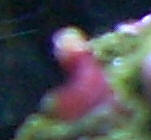
|
|
Unknown critter -02/08/08 Hi, I want to
thank you for all of the great advice that you give, you have
been right on with everything I¹ve ever asked, and I
greatly appreciate it. Recently I have found a new animal in my
45 gallon reef tank. The tank has been set up for about a year,
and noticed it about a month ago. It is a nearly flat disc shaped
animal, thicker in the center but not by much, that is dark
maroon in color with a white stripe (at first I thought the strip
was a mouth, now I¹m not sure) on top. It moves slowly
all over the live rock, and sometimes it lifts its edges. In the
attached picture you will see it in the center (the dark spot on
the rock). I think it's a pretty neat critter, and I
would love to know what it is. I don¹t have any reason
to think it¹s harmful. But I would like to know just
to be sure. Thank you, and keep up the good work, <Lucky you!
It's a Scutus. I love these guys! They're harmless algae
grazers. Enjoy. :-)
http://www.seaslugforum.net/factsheet.cfm?base=scutus Note:
I've linked you to the slug forum, but these are actually
snails, not slugs. They are often mistaken for slugs because
their shells are usually mostly hidden.> Joseph
<Best,
Sara M.>
|
|
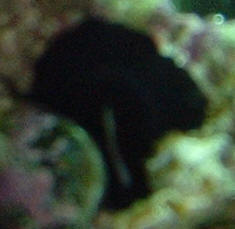
|
|
Mystery Marine Eggs, Likely Snails --
1/29/08 Hi everyone, <Hi Rochelle.> Have some mystery
eggs here I hope you can tell me what they are. No one is
guarding them or tending to them (so far, it's been 3 hours)
so I am unable to figure it out. Here are the
possibilities'¦ I have '¦ 3 Percula clownfish,
(but when I looked up their eggs, it showed them yellow then
turning to orange/red as they develop) I was rather hoping they
were clownfish. I have 2 mated 3 strip damsels, BUT.. the male is
currently tending to his own eggs on the opposite side of the
tank, so that can't be it. <Correct. Neither of these
species lay/deposit eggs in strands.> 1 magenta dotty back,
she has her own private cave. If they were hers you'd think
she would've laid them in there, not on a rock outside. 1
Hawkfish, I think he's a male and wouldn't have laid eggs
out in the open if he was female. 1 chromis damsel, 1 mandarin
goby, 1 clown goby and some pink foot snails. I don't think
it was the snails, they weren't in the area at the time the
eggs 'appeared'. <Heeee! They're sneaky that way.
I don't know what species the 'pink foot snail' is,
but that egg strand looks like it came from either a snail or
Nudibranch of some sort.> I do have some crabs, blue legs, a
sally and a hermit, but that can't be right, crabs don't
lay eggs like that do they? <No, they don't.> When I
looked up the different fish I have, and what their eggs look
like, my eggs don't look like any of them. So do you think
they are clownfish? <Alas, no. It's more than likely a
"snail trail".> If so I'd like to move them to
my nursery tank (already to go with micro food stuffs). If you
think they belong to any other fish I'll leave them be. Due
to them not having a mate to fertilize them. <That's how
I'd handle these - leave them and let 'nature' take
its course.> Thanks in advance, <You're very welcome.
Take care. -Lynn>
|
|
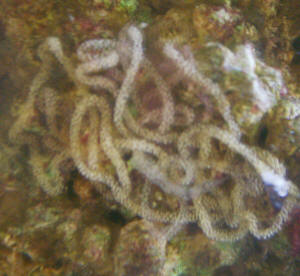
|
|
Cucumber?-01/29/2008 Hi guys! Can you help
with an ID? This looks like a cucumber growing from the skeleton
on my neon green candy. Am I correct? <Does it move? It looks
like a sponge or possibly even some kind of soft coral. But
it's hard to tell from the pic. Does it change at night?
(i.e. open up at all?)> Thanks, Geno
http://i127.photobucket.com/albums/p151/gdevine_photo/DSC00056.jpg
<De nada, Sara M.>
Re: Cucumber? 1/29/08 Hi Sara - Thanks for
the quick response. After some thought, it can't be a
cucumber because it doesn't move. It may be a sponge,
that's my original thought but it's growing from both
ends and the lights from my HO T5's don't bother it; and
most sponges don't like light intense light from what I
understand. <It depends on the sponge. Some are
"indifferent" to light. And some change color depending
on the kind of light they are under. I have some bright yellow
sponge that apparently doesn't mind light at all (it has
growing merrily directly under a 250w MH light for years now).
So, again, it just depends on the sponge.> I've not seen
any changes at night but I'll check it out later tonight
again and see if it changes. I feed my Sun Cups DT's and
freeze dried Cyclops each night target feeding and nothing opens
up even with all these nutrients floating around... <If
it's a sponge, it is likely appreciating the DT's.
:-)> I think you're right, it's some form of a soft
coral... <Could be... those white dots look like they could be
closed polyps.> got to love the mystery of this hobby!
<Yep>
Thanks again!
Geno
<De nada,
Sara M.>
|
|
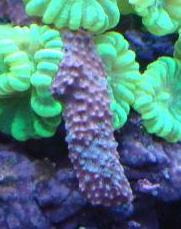
|
|
Help with gunk in my reef! - 1/24/08 Hi Bob (and crew):
It's been along time since I've emailed for help, but I
thought you'd be the ones to ask! I have this grayish white
gunk growing all over my live rock and some threatening to grow
over some corals I have, but I try and siphon it out when
possible. It's very unsightly and even grows on the glass,
looks like small white/clear filaments. I've attached a photo
and link to a video I took, I'm hoping you could help out. My
tank parameters are: Temp 78.5SG 1.025Mg 1280Ca 320 (I've
struggled to get this higher than 380)KH 9ph 8.3phosphates 0
Videohttp://smg.photobucket.com/albums/v121/cgoldens/Fish/ID%20File/?action=view¤t=gunk002.flv
Picture attached. Thanks in advance! <Mmm, looks like some
sort of mix of sponges, algae... perhaps decomposers... You need
more circulation, perhaps other means to raise RedOx... I'd
be reading re algae control for input here...:
http://wetwebmedia.com/marine/maintenance/index.htm Scroll down
to a lower tray. BobF>
Re: help with gunk in my reef! - 1/24/08 I think it
might be Dinos, am I off base? <Yep> btw, I have a 180G in
wall setup, powered by a 3600 gph sequence dart, I wasn't
sure flow was an issue. I just added a 1200gph Koralia pump 2
days ago for more movement. Thanks!
Chris
<Keep reading. B>
|
|
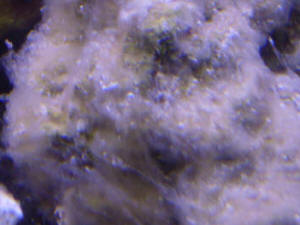
|
| Strange White Things: Syconoid sponges --
1/19/08 <Hi there> Do you guys know what that white thing
is? I have a few of those in my tank. <They're harmless,
filter feeding sponges in the genus Sycon, also called Syconoid
sponges. For more information/photos, please see the FAQ's at
this link (and related links above):
http://www.wetwebmedia.com/spgidf7.htm . Take care -Lynn> |
|
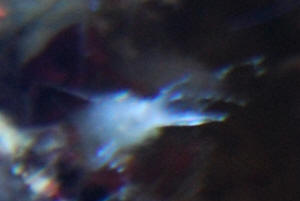
|
Worm? Nope, Ophiuroid! 1/19/08 Hi Crew at
WetWebMedia! <Hi Trina!> First, thank you for this invaluable
resource. Our first marine tank is off to a wonderful, successful
start (at least, we think so). <Terrific!> Most of the things
we've had questions about we were able to ID using your site,
however, this particular thing has us confused. I thought it was a
hair worm, but the pics of them that I've seen, they appear
smooth and these are segmented. There are two different rocks that
have one spot of 4 antennae each. It is segmented with alternating
segments having dark spots on them, plus, one antennae seems to
have two parts - a main tube and then another skinnier antennae
coming out of it. In the pic, the thickest tube is third from the
left of the picture. The things get longer at night and responds to
touch but never leaves its location. <Typical for these
guys.> Set-up: 48 gallon bow-front tank, Eheim Ecco 2236
canister filter, Coralife super skimmer, 1 AquaClear50 powerhead, 2
Rio90 powerheads, ~50 pounds live rock, 3" DSB(live), <Bare
minimum for a DSB.> Hydor in-line heater, Coralife Aqualight
2X96watts. The tank is 4 months old and is running really well and
consistent. <Very good.> Living stuff: 2 ocellaris (we think)
clowns, 1 royal Gramma, small pink leather coral, purple/brown
zoanthid, purple/neon green xenia, purple mushroom polyp, many
snails of many types, several clumps of Halimeda, and a bunch of
tubular calcareous sponges that developed recently. <Likely
Syconoid sponges. Please Google 'Sycon' or
'Syconoid' at WWM for comparison/more information:
http://www.wetwebmedia.com/Googlesearch.htm> Finally, is this a
safe creature or bad creature? Either way, it gives me nightmares :
) Sorry the pic is fuzzy, I had to take it zoomed in a whole lot.
<Heeeee! No need for nightmares, and the picture is just fine.
These are harmless/beneficial little Ophiuroids (Brittlestars) -
likely one of the 'mini' varieties that hitchhike in with
live rock. What you're seeing are their little arms waving
about in the current in hopes of catching a bit of food floating
by. For more information, please Google 'mini brittlestar'
at the above link. Here's a link to get you started:
http://www.wetwebmedia.com/brittlestaridfaqs.htm .> Thanks!
Trina
<You're very welcome! Take care --Lynn> |
|
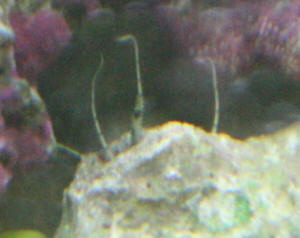
|
Identity... of... 1/14/08 Dear
Crew, <Hi Ann, Mich here.> I would like to thank you for your
time and expertise. <I would like to apologize for my very tardy
reply.> I have sent two attachments of some live rock in my 55
gallon. <I see.> My tank contains one Ocellaris Clownfish, a
"Flower Anemone", a large feather duster, and a dozen
blue-legged hermit crabs. It used to have a flame scallop in it.
<Flame scallops don't do well in captivity. I would
avoid.> Getting to the point of the pictures. I would like some
help on identifying some new inhabitants. I have 1/4" tubular
growths that are spreading like wildfire across my tank. Like
always they are hard to rid of. <They are Syconoid sponges,
beneficial filter feeders, their populations usually wax and
wane.> The second picture is of my so-called " Flower
Anemone". <Does not look like a flower anemone to me.>
My LFS doesn't usually have scientific names available. I did
some research, but I am suspecting this is not a Flower Anemone.
<I would agree.> I have a feeling it is something else.
I'm just looking for some scientific names to start my research
on it. <I asked Brenda Furtak our anemone expert to take a look,
she thought it was either a BTA or E. Quadricolor.> Any help is
greatly appreciated. I am extremely sorry for the quality of the
pictures. <Not always easy to get the pics you want when the
subject lives in an aquarium.> I hope I did everything right, I
fear the rath <wrath> of the WWM crew. <Nothing to fear
here'¦ yes, Bob can be bit cantankerous at times, but
think about how you'd feel when you've devoted much of your
life to improving the lives of others and how frustrated you'd
feel when folks won't help themselves.> Happy New Year,
<And to you and yours. Mich>
Ann |
|
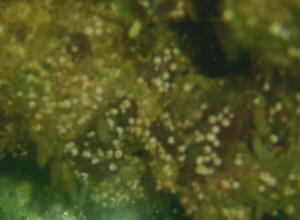
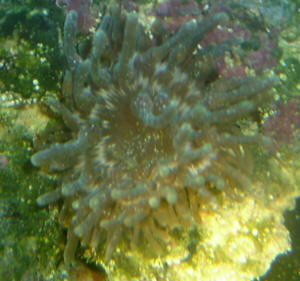
|
White spots... Alcyonacean hlth., reading
1/14/08 Hello...again. <Matt> Could you possible identify two
items for me? First on my live rock, round circular spots have started
to form. It has been a week and one or two form each day. I do not
believe they are eggs, but am unsure. <Need a more highly resolved,
closer up pic... could be algae, forams... maybe Spirorbids...>
Second, my leather coral is developing white "marks" as well.
I thought this to bleaching, but again I am unsure. I will admit that
my calcium was a bit high (500ppm), <This is more than a bit...>
but I did a water change and it is back in line (right at 400ppm). PH
8.2, Alk 2.5, <A bit low...> temp 78, almost undetectable
nitrites and 0ppm phosphates. <All life needs some phosphate> If
you have any thoughts, I am always willing to listen. <And hopefully
to read> As always , thanks! M <Start here:
http://wetwebmedia.com/marine/inverts/index.htm Scroll down to Soft
Corals, Health, Systems, more definitively for Alcyoniids...
BobF>
Re: White spots 1/14/08 Bob, Thanks for the
reply! Wanted to let you know I purchased the books you recommend on
corals! It is a great reference. I believe I identified the small white
spots appearing randomly in my tank. I recently(two weeks ago) added 2
Nerite Snails to the tank. I believe the spots which look like sesame
seeds to be their eggs. I have seen pictures online and they look just
like them. Could this be possible? <Ah, yes. Certainly>
Thanks!
M
<Welcome. B>
|
|

